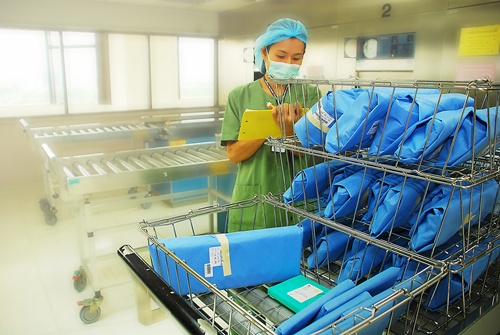A Day in the Life of a Sterile Processing Technician
Every day, sterile processing technicians (also known as CSSD technicians or sterilization supply techs) play a vital role in ensuring that patients receive the care they need.
From start to finish, they are responsible for cleaning, organizing, and sterilizing all of the medical equipment used by surgeons and other medical professionals.
It’s a big job, but someone has to do it!
Let’s take a look at what a typical day is like for a sterile processing technician.
Overview
The typical day of a sterile processing technician starts early in the morning, usually around 6:00 or 7:00 am.
The first order of business is to check that all of the necessary equipment is clean and ready to go for the day. This includes making sure that autoclaves are turned on and reach the correct temperature, checking that surgical packs are correctly assembled, and ensuring that all supplies are properly stocked.
After everything has been checked and double-checked, it’s time to start sterilizing instruments.
Sterilization Methods
Sterile processing technicians use a variety of methods to sterilize instruments, including autoclaves, dry heat ovens, ethylene oxide gas chambers, and ultraviolet germicidal irradiation units.
Each type of sterilizer has its own operating instructions that must be followed to the letter in order to prevent cross-contamination.
Once sterilization is complete, instruments are typically stored in sterile containers or wrapped in sterile packages until they are needed for surgery.
Documentation
Throughout the day, sterile processing technicians must maintain meticulous records of all activities related to instrument sterilization.
This includes keeping track of what was sterilized, when it was done, and how long it took.
Sterile processing technicians also perform regular maintenance on all equipment and report any problems to their supervisor immediately.
In some cases, they may even be responsible for teaching other members of the medical team about proper sterile processing procedures.
Typical day in the life of a Sterile Processing Technician
8:00 AM – Arrive at work and check sterility indicator strips on autoclaves. Check that all needed supplies are stocked.
9:00 AM – Start decontamination process by precleaning all instruments with enzymatic solution.
10:00 AM – Soak instruments in chemical disinfectant solution. After instruments have soaked, wash and rinse them thoroughly.
11:00 AM – Inspect instruments for cleanliness and damage. Assemble clean instruments into sets using wrapping paper or trays. Place sets into sterilizer bags. Seal bags using an autoclave or dry heat unit.
Load Autoclave with correct number of sterilizer bags containing instrument sets. Pressurize autoclave according to manufacturer’s instructions and run cycle. Remove autoclaved items from chamber when cycle is complete.
Let items cool down before handling . Unwrap instrument sets and return them to their proper storage location . Clean work area and restock supplies as needed.
1:00 PM – Take a lunch break.
2:00 PM – Repeat morning routine as necessary until all dirty instruments have been decontaminated, cleaned, assembled, and sterilized .
3:00 PM – Disinfect work area and equipment . Empty dirty instruments from washer-disinfector basin . Take out trash . Restock supplies as necessary.
4:00 PM – Depart work for the day.
The typical work day of a Sterile Processing technician vary depending on the size of the facility. Some technicians may be responsible for additional tasks such as processing medical records, ordering supplies, or training new employees. Others may work in sterile supply rooms where they assemble and distribute instrument trays and surgical kits. Many technicians work evening, weekend, or overnight shifts to keep hospitals staffed 24 hours a day.
For bigger facilities, there may be a lead technician who oversees the work of other technicians. The lead technician may also be responsible for quality control, documenting equipment maintenance, or performing in-service education for hospital staff.
For smaller facilities, the technician may be the only one responsible for all aspects of the decontamination, cleaning, assembly, and sterilization process. The technician may also be responsible for maintaining sterile supply rooms and distributing instruments and surgical kits to hospital staff.
For dental facilities, the technician may be responsible for autoclaving dental instruments and materials, setting up operatories for procedures, and sterilizing dental handpieces.
Note: This is just a typical day Sterile Processing Technician. Responsibilities and tasks may vary depending on the employer.
Competencies of a Sterile Processing Tech
Sterile Processing technicians must follow strict sterile processing guidelines to ensure that instruments are properly decontaminated, cleaned, and sterilized.
These guidelines are put in place to protect patients from infection. In some states, Sterile Processing technicians are required to be certified by the International Association of Healthcare Central Service Materiel Management (IAHCSMM).
Certification is not required in all states, but many employers prefer to hire technicians who have been certified. Certification shows that a technician has the knowledge and skills necessary to perform the job. Sterile Processing technicians who are certified may have better job prospects and may be able to earn higher salaries.
IAHCSMM offers several different certification levels, including Certified Registered Central Service Technician (CRCST), Certified Central Service Technician (CCST), and Certified Lead Central Service Technician (CLCST).
To be eligible for certification, technicians must have a certain amount of work experience and must pass a written exam. The CRCST is the entry-level certification, and the CLCST is the highest level of certification that IAHCSMM offers.
Sterile Processing technicians who are certified may use the initials CRCST, CCST, or CLCST after their names.
Conclusion
As you can see, being a sterile processing technician is a demanding but important job.
Sterile processing technicians play a vital but often unseen role in ensuring that patients receive quality care. From start to finish, they are responsible for cleaning, organizing, and sterilizing all of the medical equipment used by surgeons and other medical professionals.
Being a Sterile Processing Technician can be a great way to get started in the medical field, and it offers opportunities for growth and advancement. If you’re detail-oriented and have good organizational skills, this may be the perfect career for you!
Thanks for reading and I hope you have a better understanding of what sterile processing technicians do on a daily basis.
Are you a Sterile Processing Tech? How does your typical work day look like? Please share in the comments below!




I’m interested in the Cssd Technician course